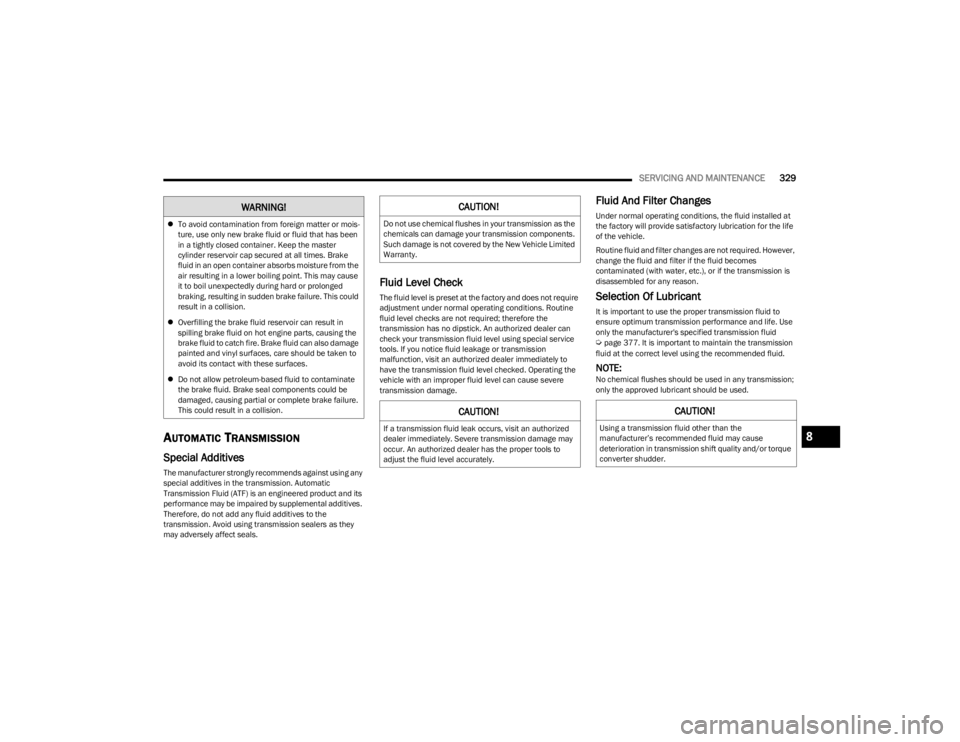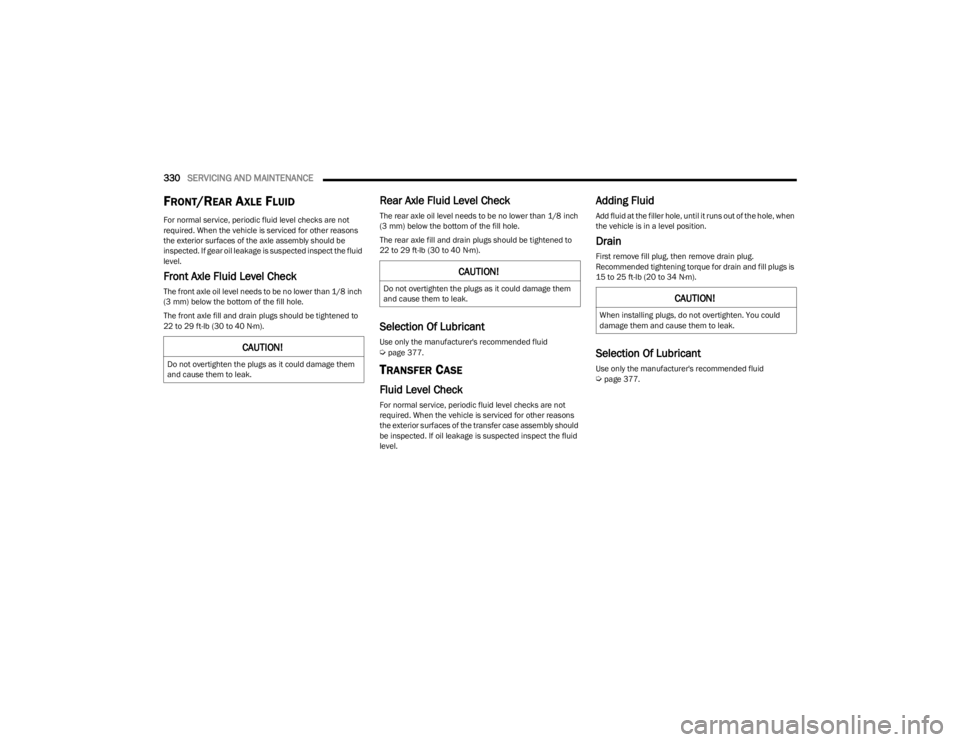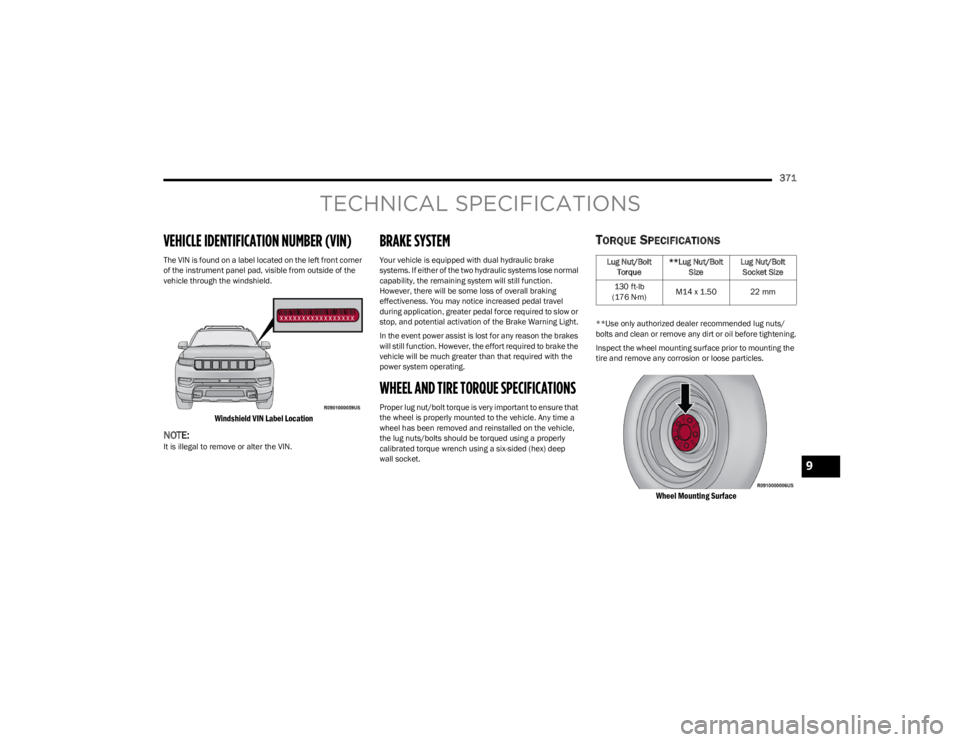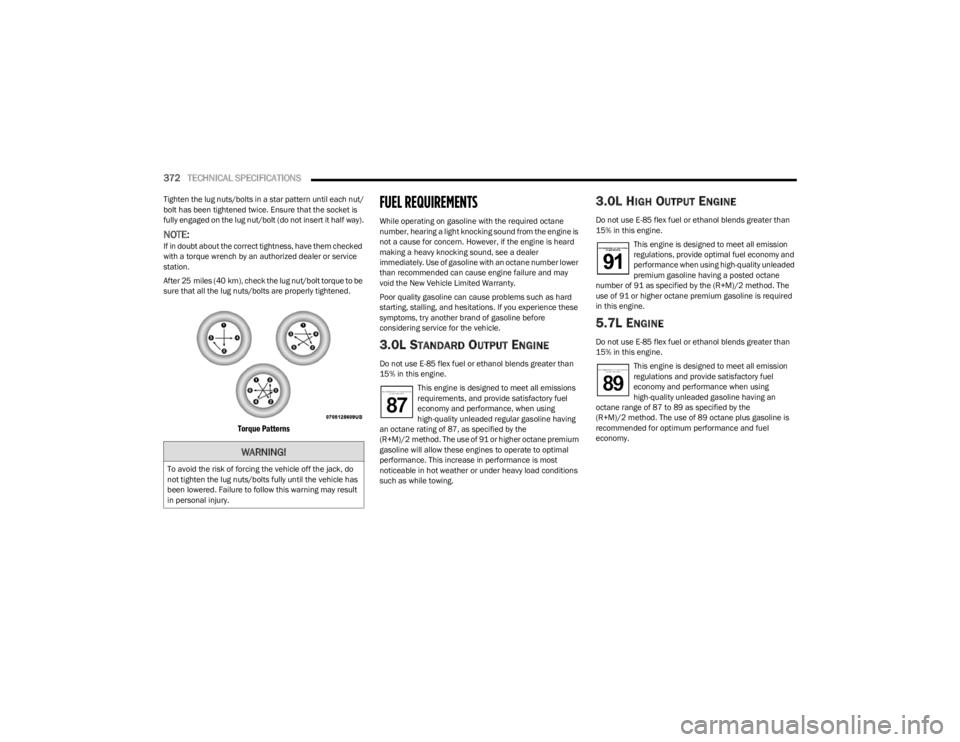torque JEEP WAGONEER 2023 Owner's Manual
[x] Cancel search | Manufacturer: JEEP, Model Year: 2023, Model line: WAGONEER, Model: JEEP WAGONEER 2023Pages: 396, PDF Size: 15.17 MB
Page 331 of 396

SERVICING AND MAINTENANCE329
AUTOMATIC TRANSMISSION
Special Additives
The manufacturer strongly recommends against using any
special additives in the transmission. Automatic
Transmission Fluid (ATF) is an engineered product and its
performance may be impaired by supplemental additives.
Therefore, do not add any fluid additives to the
transmission. Avoid using transmission sealers as they
may adversely affect seals.
Fluid Level Check
The fluid level is preset at the factory and does not require
adjustment under normal operating conditions. Routine
fluid level checks are not required; therefore the
transmission has no dipstick. An authorized dealer can
check your transmission fluid level using special service
tools. If you notice fluid leakage or transmission
malfunction, visit an authorized dealer immediately to
have the transmission fluid level checked. Operating the
vehicle with an improper fluid level can cause severe
transmission damage.
Fluid And Filter Changes
Under normal operating conditions, the fluid installed at
the factory will provide satisfactory lubrication for the life
of the vehicle.
Routine fluid and filter changes are not required. However,
change the fluid and filter if the fluid becomes
contaminated (with water, etc.), or if the transmission is
disassembled for any reason.
Selection Of Lubricant
It is important to use the proper transmission fluid to
ensure optimum transmission performance and life. Use
only the manufacturer's specified transmission fluid
Úpage 377. It is important to maintain the transmission
fluid at the correct level using the recommended fluid.
NOTE:No chemical flushes should be used in any transmission;
only the approved lubricant should be used.
To avoid contamination from foreign matter or mois -
ture, use only new brake fluid or fluid that has been
in a tightly closed container. Keep the master
cylinder reservoir cap secured at all times. Brake
fluid in an open container absorbs moisture from the
air resulting in a lower boiling point. This may cause
it to boil unexpectedly during hard or prolonged
braking, resulting in sudden brake failure. This could
result in a collision.
Overfilling the brake fluid reservoir can result in
spilling brake fluid on hot engine parts, causing the
brake fluid to catch fire. Brake fluid can also damage
painted and vinyl surfaces, care should be taken to
avoid its contact with these surfaces.
Do not allow petroleum-based fluid to contaminate
the brake fluid. Brake seal components could be
damaged, causing partial or complete brake failure.
This could result in a collision.
WARNING!CAUTION!
Do not use chemical flushes in your transmission as the
chemicals can damage your transmission components.
Such damage is not covered by the New Vehicle Limited
Warranty.
CAUTION!
If a transmission fluid leak occurs, visit an authorized
dealer immediately. Severe transmission damage may
occur. An authorized dealer has the proper tools to
adjust the fluid level accurately.
CAUTION!
Using a transmission fluid other than the
manufacturer’s recommended fluid may cause
deterioration in transmission shift quality and/or torque
converter shudder.8
23_WS_OM_EN_USC_t.book Page 329
Page 332 of 396

330SERVICING AND MAINTENANCE
FRONT/REAR AXLE FLUID
For normal service, periodic fluid level checks are not
required. When the vehicle is serviced for other reasons
the exterior surfaces of the axle assembly should be
inspected. If gear oil leakage is suspected inspect the fluid
level.
Front Axle Fluid Level Check
The front axle oil level needs to be no lower than 1/8 inch
(3 mm) below the bottom of the fill hole.
The front axle fill and drain plugs should be tightened to
22 to 29 ft-lb (30 to 40 N·m).
Rear Axle Fluid Level Check
The rear axle oil level needs to be no lower than 1/8 inch
(3 mm) below the bottom of the fill hole.
The rear axle fill and drain plugs should be tightened to
22 to 29 ft-lb (30 to 40 N·m).
Selection Of Lubricant
Use only the manufacturer's recommended fluid Úpage 377.
TRANSFER CASE
Fluid Level Check
For normal service, periodic fluid level checks are not
required. When the vehicle is serviced for other reasons
the exterior surfaces of the transfer case assembly should
be inspected. If oil leakage is suspected inspect the fluid
level.
Adding Fluid
Add fluid at the filler hole, until it runs out of the hole, when
the vehicle is in a level position.
Drain
First remove fill plug, then remove drain plug.
Recommended tightening torque for drain and fill plugs is
15 to 25 ft-lb (20 to 34 N·m).
Selection Of Lubricant
Use only the manufacturer's recommended fluid Úpage 377.
CAUTION!
Do not overtighten the plugs as it could damage them
and cause them to leak.
CAUTION!
Do not overtighten the plugs as it could damage them
and cause them to leak.CAUTION!
When installing plugs, do not overtighten. You could
damage them and cause them to leak.
23_WS_OM_EN_USC_t.book Page 330
Page 373 of 396

371
TECHNICAL SPECIFICATIONS
VEHICLE IDENTIFICATION NUMBER (VIN)
The VIN is found on a label located on the left front corner
of the instrument panel pad, visible from outside of the
vehicle through the windshield.
Windshield VIN Label Location
NOTE:It is illegal to remove or alter the VIN.
BRAKE SYSTEM
Your vehicle is equipped with dual hydraulic brake
systems. If either of the two hydraulic systems lose normal
capability, the remaining system will still function.
However, there will be some loss of overall braking
effectiveness. You may notice increased pedal travel
during application, greater pedal force required to slow or
stop, and potential activation of the Brake Warning Light.
In the event power assist is lost for any reason the brakes
will still function. However, the effort required to brake the
vehicle will be much greater than that required with the
power system operating.
WHEEL AND TIRE TORQUE SPECIFICATIONS
Proper lug nut/bolt torque is very important to ensure that
the wheel is properly mounted to the vehicle. Any time a
wheel has been removed and reinstalled on the vehicle,
the lug nuts/bolts should be torqued using a properly
calibrated torque wrench using a six-sided (hex) deep
wall socket.
TORQUE SPECIFICATIONS
**Use only authorized dealer recommended lug nuts/
bolts and clean or remove any dirt or oil before tightening.
Inspect the wheel mounting surface prior to mounting the
tire and remove any corrosion or loose particles.
Wheel Mounting Surface
Lug Nut/Bolt Torque **Lug Nut/Bolt
Size Lug Nut/Bolt
Socket Size
130 ft-lb
(176 N·m) M14 x 1.50 22 mm
9
23_WS_OM_EN_USC_t.book Page 371
Page 374 of 396

372TECHNICAL SPECIFICATIONS
Tighten the lug nuts/bolts in a star pattern until each nut/
bolt has been tightened twice. Ensure that the socket is
fully engaged on the lug nut/bolt (do not insert it half way).
NOTE:If in doubt about the correct tightness, have them checked
with a torque wrench by an authorized dealer or service
station.
After 25 miles (40 km), check the lug nut/bolt torque to be
sure that all the lug nuts/bolts are properly tightened.
Torque Patterns
FUEL REQUIREMENTS
While operating on gasoline with the required octane
number, hearing a light knocking sound from the engine is
not a cause for concern. However, if the engine is heard
making a heavy knocking sound, see a dealer
immediately. Use of gasoline with an octane number lower
than recommended can cause engine failure and may
void the New Vehicle Limited Warranty.
Poor quality gasoline can cause problems such as hard
starting, stalling, and hesitations. If you experience these
symptoms, try another brand of gasoline before
considering service for the vehicle.
3.0L STANDARD OUTPUT ENGINE
Do not use E-85 flex fuel or ethanol blends greater than
15% in this engine.
This engine is designed to meet all emissions
requirements, and provide satisfactory fuel
economy and performance, when using
high-quality unleaded regular gasoline having
an octane rating of 87, as specified by the
(R+M)/2 method. The use of 91 or higher octane premium
gasoline will allow these engines to operate to optimal
performance. This increase in performance is most
noticeable in hot weather or under heavy load conditions
such as while towing.
3.0L HIGH OUTPUT ENGINE
Do not use E-85 flex fuel or ethanol blends greater than
15% in this engine.
This engine is designed to meet all emission
regulations, provide optimal fuel economy and
performance when using high-quality unleaded
premium gasoline having a posted octane
number of 91 as specified by the (R+M)/2 method. The
use of 91 or higher octane premium gasoline is required
in this engine.
5.7L ENGINE
Do not use E-85 flex fuel or ethanol blends greater than
15% in this engine.
This engine is designed to meet all emission
regulations and provide satisfactory fuel
economy and performance when using
high-quality unleaded gasoline having an
octane range of 87 to 89 as specified by the
(R+M)/2 method. The use of 89 octane plus gasoline is
recommended for optimum performance and fuel
economy.
WARNING!
To avoid the risk of forcing the vehicle off the jack, do
not tighten the lug nuts/bolts fully until the vehicle has
been lowered. Failure to follow this warning may result
in personal injury.
23_WS_OM_EN_USC_t.book Page 372
Page 392 of 396

390
Sun ScreensSecond Row Seats ..................................................... 76
Sun Visor..........................................................................51
Sunglasses Storage ........................................................73
Surroundview Camera ................................................. 175
Sway Control, Trailer .................................................... 247
Synthetic Engine Oil ..................................................... 319
System, Remote Starting ................................................22
TTelescoping Steering Column ........................................30
Temperature Control, Automatic (ATC) ..........................71
Third Party Apps ........................................................... 226
Third Row USB.................................................................78 Tie Down Hooks, Cargo...................................................89Tilt Steering Column ....................................................... 30
Tire And Loading Information Placard ........................ 354
Tire Markings................................................................ 349
Tire Safety Information ................................................ 349 Tires ................................................... 289
, 357, 361, 366
Aging (Life Of Tires) ................................................. 359
Air Pressure.............................................................. 357
Chains ...................................................................... 364
Changing .................................................................. 293
Compact Spare ........................................................ 361
General Information ...................................... 357
, 361
High Speed .............................................................. 358
Inflation Pressure ....................................................357 Life Of Tires .............................................................. 359
Load Capacity .......................................................... 354
Pressure Monitoring System (TPMS) ........... 114
, 252
Quality Grading ........................................................ 366
Radial ....................................................................... 358
Replacement ...........................................................360
Rotation....................................................................366 Safety ............................................................. 349
, 357
Sizes ......................................................................... 350
Snow Tires................................................................ 361 Spare Tires ........................................... 295
, 361, 362
Spinning ................................................................... 359
Trailer Towing .......................................................... 186
Tread Wear Indicators ............................................ 359
Wheel Nut Torque ................................................... 371
To Open Hood ................................................................. 85
Tongue Weight/Trailer Weight..................................... 185
Tow/Haul Mode ............................................................ 129
Towing ........................................................ 115
, 178, 306
Disabled Vehicle...................................................... 306
Guide........................................................................ 182
Recreational ............................................................ 190
Weight ...................................................................... 182
Towing Behind A Motorhome ...................................... 190
Traction Control ............................................................ 246
Traffic Sign Recognition System.................................. 146
Trailer Sway Control (TSC) ........................................... 247
23_WS_OM_EN_USC_t.book Page 390